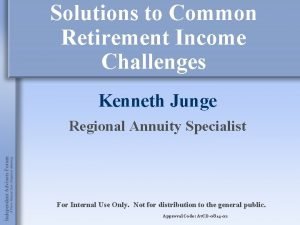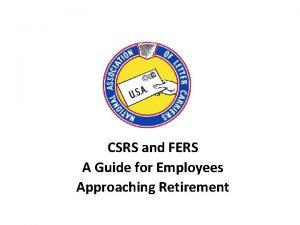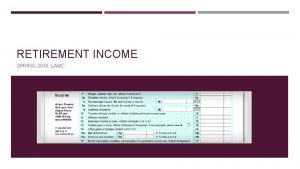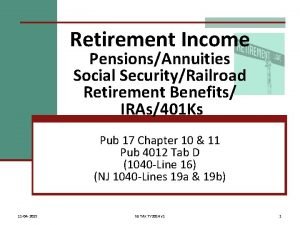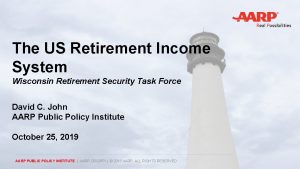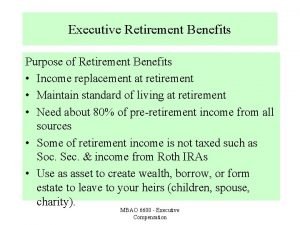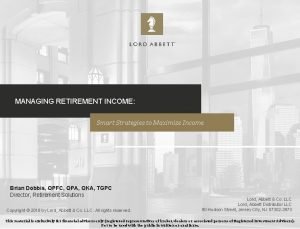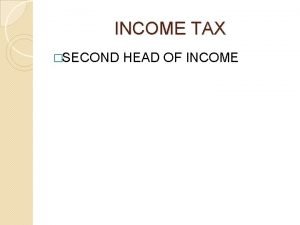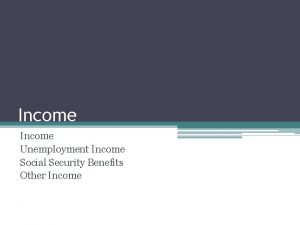Solutions to Common Retirement Income Challenges Kenneth Junge



































- Slides: 35

Solutions to Common Retirement Income Challenges Kenneth Junge Regional Annuity Specialist For Internal Use Only. Not for distribution to the general public. Approval Code: A 7 CD-0814 -02

Today’s Agenda ►Solving for Client’s Income Needs ►Common Retirement Concerns ►Pension Style Income

Solving for Income Needs True Retirement Planning Asset Buckets IRA Income Need Variable Living Expenses $2, 600 (travel, gifting) Investments Fixed Income Basic Living Expenses $5, 400 (housing, food, insurance, auto) Financial Solutions

Solving For Income Needs Non Essential Living Expenses Core Living Expenses Vacation $1, 050 Housing $3, 050 Hobby / Entertainment $450 Utilities $450 Family Gifting $600 Charity $500 Monthly Total: $2, 600 Monthly Total: $8, 000 Food $600 Insurance $500 Transportation $350 Taxes $450 Monthly Total: $5, 400

Determining Income Needs Sources of Retirement Income 58% From Your Own Resources Social Security 19% Earned Income 40% Pension 21% Your Own Investments 18% 40% From Outside Sources Source: Social Security Administration, Office of Policy, Income of the Aged Chartbook 2004, Key Sources of retirement income for households with incomes of $40, 000 or more per year. For illustrative purposes only.

Solving for Income Needs Pension Style Income Variable Living Expenses $3, 400 Gap! $2, 600 (travel, gifting) Basic Living Expenses $5, 400 (housing, food, insurance, auto) Pension Style Income Social Security $1, 500 • • • Pension $500 Dependable Income Guaranteed for Life Inflationary Protection

Today’s Agenda ►Solving for Client’s Income Needs ►Common Retirement Concerns ►Pension Style Income

Common Concerns ►Static or Fixed Income Strategies ►Unprotected Withdrawal Strategies ►Chasing Market Performance

Common Concerns Fixed Income Strategies 1965 $1. 00 2005 0. 17¢ Source: Headline Consumer Price Index

Common Concerns Which Income Stream Would You Prefer? Historical Change in the Consumer Price Index for All Urban Consumers (CPI-U) 2000 2001 1. 6% $5, 484 $5, 400 2002 2. 4% $5, 614 $5, 400 2003 1. 9% $5, 720 $5, 400 2004 3. 3% $5, 906 $5, 400 2005 3. 4% $6, 108 2006 2. 5% $6, 263 $5, 400 Actual purchasing power after six years = $4, 637 This is a hypothetical illustration of mathematical principles and does not predict or project the performance of a particular investment or investment strategy

Common Concerns Fixed Income Strategies ► Stable Income ► Guaranteed for the Clients Life ► Maintain Purchasing Power

Common Concerns Unprotected Withdrawal Strategies Timing is everything when it comes to taking income withdrawals from assets invested in the stock market. This example is hypothetical and is for illustrative purposes only and not meant to represent the performance of any particular investment. It assumes a 7% average annualized return on a $250, 000 value rounded to the first decimal. The various columns are intended to demonstrate the impact of the sequence of returns, assuming 5% annual withdrawals of $12, 500 (increasing at 3% annually for inflation). Past performance does not guarantee future results. If this were an actual variable annuity, various costs would be factored into the gross return, including annual insurance and administrative charges of the annuity, annual contract charges, investment management fees of the variable subaccounts, the cost for any optional features, and any other applicable fees, which would lower performance.

Common Concerns Unprotected Withdrawal Strategies Recent Market Performance Mutual Fund 5% Withdrawal 8% Withdrawal Fidelity Magellan $47, 797 $19, 175 Vanguard 500 Index $56, 166 $25, 081 American Funds Invst. Co. of America $92, 133 $59, 150 American Funds Washington Mutual $105, 523 $72, 360 Fidelity Growth and Income $59, 971 $31, 351 Fidelity Contra $83, 630 $48, 361 American Century Ultra $30, 403 $5, 212 Janus Fund $27, 595 $0 Janus Twenty $17, 238 $0 American Funds Euro Pacific $81, 499 $40, 039 A hypothetical $100, 000 balance would have fared from Dec. 31, 1999, thru March, 31 2007 in these funds after regular withdrawals Source: USA Today 4/27/07 Funds ranked by assets on 12/31/1999. Dividends and gains reinvested. Withdrawals increased by 3% annually for inflation. Source: Lipper. Past performance is not indicative of future results. Values are inclusive of fees and charges. Actual client expenses may vary

Common Concern Unprotected Withdrawal Strategies T. Rowe Price Capital Appreciation Fund vs. American Funds Washington Mutual Fund Source: Yahoo Finance: Dec. 31, 1999 - March 2007 Past performance is not indicative of future results

Common Concerns Unprotected Withdrawal Strategies Monte Carlo – Historical Perspective Source T. Rowe Price Associates: The withdrawal rate is the percentage of assets withdrawn during the first year of retirement and assumes that the amount is increased by 3% annually to account for inflation. The probability of success is determined by running 500 market scenarios that account for a wide variety of market return possibilities. These results may vary with each use and over time.

Common Concerns Monte Carlo Important Legal Information: This exhibit is not intended to project or predict the present or future value of the actual holdings in a participant’s portfolio or of the performance of a given model portfolio of securities. The calculations and results generated are based upon historical performance analysis of the stated asset groups, goals and assumptions. The historical annual data utilized is from 1926 through 2002 and is from Ibbotson Associates: stocks, bonds, and short-term investments are represented by S&P 500, U. S. Int. Government Bonds, and U. S. 30 -day T-bills. Investors may be charged fees when investing in an actual portfolio of securities, which are not reflected in illustrations utilizing returns or market segments. This exhibit was calculated from several hundred financial market return scenarios run to determine how the asset mixes may have performed. A 90% confidence level was utilized, indicating that the percentage of assets withdrawn annually could have been supported for the number of years noted in 90% of the historical scenarios that were generated. For example, the assets could have supported a 4% withdrawal rate for 33 years in 238 of 250 scenarios. The purpose of this hypothetical illustration is to show portfolios may be created with different risk and return characteristics to help meet a participant’s goals. You should choose your own investments based on your particular objectives and situation. Remember, you may change how your account is invested. Be sure to review your decisions periodically to make sure they are still consistent with your goals. You should also consider all of your investments when making your investment choices.

Common Concerns Unprotected Withdrawal Strategies ►Stable Income ►Guaranteed for the Clients Life ►Maintain Purchasing Power

Common Concerns Chasing Market Performance S&P Returns for 20 years 1986– 2005 11. 9% S&P 500 “Buy and Hold” 3. 9% “Average” Investor Return Source: Dalbar, Inc. , Quantitative Analysis of Investor Behavior 2006. Dalbar defines the average investor as the universe of all mutual fund investors whose actions and financial results are restated to represent a single investor. The study calculates the Average Investor Return as the change in assets, after excluding sales, redemptions and exchanges. This calculation captures realized and unrealized capital gains, dividends, interest, trading costs, sales charges, fees, expenses and any other costs. The total investor return rate is determined by calculating the investor return dollars as a percentage of the net sales, redemptions and exchanges for the period. The S&P 500 index is an unmanaged index of 500 stocks from a broad range of industries whose collective performance mirrors the overall stoack market. Once cannot invest directly in an index. Past performance is not indicative of future results.

Common Concerns Chasing Market Performance ► Stable Income ► Guaranteed for the Clients Life ► Maintain Purchasing Power

Today’s Agenda ►Solving for Client’s Income Needs ►Common Retirement Concerns ►Pension Style Income

Pension Style Income Variable Annuity Features Variable Annuities Benefits: Considerations: ► Tax Deferred Growth ► Participation in the Market ► Insurance Protection ► Lifetime Income ► Annuitization ► IRS Penalties May Apply ► Market Risk ► Cost of Insurance ► Surrender Penalties May Apply Investors should carefully consider the fund’s objectives, risk, charges, and expenses before investing, as it contains this and other pertinent information.

Pension Style Income Living Benefit Riders: Possible Benefits ► Stable Income ► Guaranteed for Life & Life of Spouse ► Maintain Purchasing Power – PPP Rider ► Market Participation Benefits are available through optional riders ► Principal Protection ► Beneficiary Protection Features inherent within a rider are available for an additional cost ► Preserve Principal

Pension Style Income Purchasing Power Protector ►Guaranteed for Single or Joint Lifetimes ►Guaranteed Withdrawals Increase Annually with the CPI ►No Cap on Inflation Adjustment, Can Never Decrease ►No Forced Allocation of Funds ►Access to Account Value – No Forced Annuitization ►GMDB Included in Price ► 65 Basis Points for Single Life (Maximum Charge 1. 25%) ► 85 Basis Points for Joint Life (Maximum Charge 1. 25%) The Purchasing Power Protector and Growth & Income Protector are optional riders available with Penn Mutual’s Penn Freedom (LVA 01), Pennant Select(VAA-98) & Enhanced Credit(BVA-00) Variable Annuities. Policy form numbers may vary by state.

Pension Style Income Purchasing Power Protector Age Based Withdrawal Rates ►Under age 55 ►Ages 55 – 59 ►Ages 60 – 64 ►Ages 65 – 69 ►Ages 70 – 74 ►Age 75 and Older Percentage based on age of first withdrawal = 2. 5% = 3. 5% = 4. 5% = 5%

Pension Style Income Double Step Up Policy Charges accessed include M&E and BB Charges. Optional Rider charges also included. Indexes are unmanaged and investors cannot invest directly in an index.

Pension Style Income Guaranteed Purchasing Power Automatic Increases in Income Adjusted to Headline CPI Quickly Match and Exceed Payments of Higher Level Income The above chart is for illustration purposes only. The provided assumptions do not reflect actual performance of any investment or investment strategy and are not predictive of future results. A clients individual results may vary.

Pension Style Income Protected Withdrawal Strategies – 10% Penn’s Freedom Variable Annuity

Pension Style Income Protected Withdrawal Strategies +10% Penn’s Freedom Variable Annuity

Unprotected Withdrawal Strategies T. Rowe Price Flexibly Managed Sub-Account

Unprotected Withdrawal Strategies T. Rowe Price Flexibly Managed Sub-Account

Pension Style Income Cost of Penn’s Freedom VA Penn Freedom VA Cost Important Note Mortality, Expense and Administrative Charges 1. 45% Penn’s most expensive VA contract PPP Rider . 65% individual . 85% joint life Death Benefit -0 - Included in price of withdrawal guarantee Investment Expense . 86% No forced Asset Allocation models Total Cost: 2. 95% . 50% - 1. 5% less then industry average* * Source: VARDs Annuity Fact Book 2005

Pension Style Income Solutions to Common Concerns A variable annuity with an optional lifetime withdrawal guarantee living benefit rider Guaranteed Minimum Income? Lifetime Withdrawal Guarantees Bond Yield Investment Withdrawal Yes No Yes Guaranteed Payment for Life? Yes Through End of Set Term No Guaranteed to Maintain Purchasing Power? Yes No No Upside Potential of the Market? Yes No Yes Death Benefit? Yes No No

Summary ►Capture Market Opportunity ►Add Value to Your Clients by Not Repeating Common Mistakes ►Protect Core Living Expenses with Pension Style Income

Embracing the Opportunity ►Call Internal Marketing Specialist ● 800 -8184, option 3 ● Request Illustrations, Literature & Marketing Material ● Set Appointment with Regional Annuity Specialist ►E-mail Internal Desk ● internalsalesdesk@pennmutual. com ►Download Illustration Request Form ►https: //www. pennmutual. com/pmlwebsite/pages/P ML_Private/attachments/prodinvestments/illustrati on_request. doc

Disclaimer Penn Mutual variable products are offered through Hornor, Townsend, & Kent, Inc. , (HTK), Registered Investment Adviser, Member FINRA/SIPC, 600 Dresher Rd, Horsham, PA 19044, 215957 -7300. HTK is a wholly owned subsidiary of The Penn Mutual Life Insurance Company. Investors should carefully consider the investment objectives, risks, charges, and expenses of a variable insurance product before investing. Please carefully read the prospectuses for the relevant variable insurance product and its underlying investment options, which contain this and other information. The preceding charts are for illustrative purposes only. The provided assumptions do not reflect the actual performance of any particular investment or investment strategy and are not predictive of future results. A client’s individual results will vary. Note: Withdrawals from variable annuities prior to age 59 1/2 may result in a 10% federal tax penalty and may be subject to income tax. In addition, withdrawals taken in excess of a product’s free amount may be subject to penalty if taken within the surrender period. All guarantees are based upon the claims –paying ability of the issuer.
 Kenneth junge
Kenneth junge Kenneth rosen discrete mathematics pdf
Kenneth rosen discrete mathematics pdf Forum junge anwaltschaft
Forum junge anwaltschaft Junge ngg
Junge ngg Alte frau junge frau
Alte frau junge frau Deklination junge
Deklination junge Draußen vor der tür steht ein junge ohne schuhe im schnee
Draußen vor der tür steht ein junge ohne schuhe im schnee Ich bin ein junge und trage kleider
Ich bin ein junge und trage kleider Junge g
Junge g Gdp per capita formula
Gdp per capita formula 30% income tax
30% income tax Comprehensive income tax
Comprehensive income tax Loss contingency journal entry
Loss contingency journal entry Sdn security challenges and solutions
Sdn security challenges and solutions Managing the aging workforce challenges and solutions
Managing the aging workforce challenges and solutions Rim valuation
Rim valuation Greatest common factor of 18 and 27
Greatest common factor of 18 and 27 Common anode and common cathode
Common anode and common cathode Lcm questions
Lcm questions How to find lowest common factor
How to find lowest common factor Find the lcm of 16 24 36 and 54
Find the lcm of 16 24 36 and 54 Multiples of 9 and 21
Multiples of 9 and 21 Belinda doyle
Belinda doyle Ywca retirement fund
Ywca retirement fund William shakespare wife
William shakespare wife State of alaska retirement
State of alaska retirement Mr mogi borrowed 9000
Mr mogi borrowed 9000 Bob carlson retirement watch
Bob carlson retirement watch Oncorretirees
Oncorretirees Montana teacher retirement
Montana teacher retirement Momiji health care society
Momiji health care society Retirement savings percentile
Retirement savings percentile Fort bragg retirement services
Fort bragg retirement services Challenges faced at each stage of the family life cycle
Challenges faced at each stage of the family life cycle Region 10 rams 457 plan
Region 10 rams 457 plan Retirement age born 1967
Retirement age born 1967
